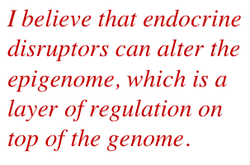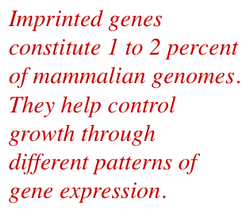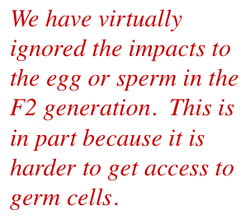How Exposures Can Modify the Epigenome
"If these chemicals impact the epigenome, this can change the programming in the germ line,
the egg and sperm and potentially be transferred across generations.
If so, with endocrine disrupting chemicals, you aren’t just impacting the person exposed,
you are impacting their children and grandchildren, and possibly their great grandchildren."

Dana Dolinoy, PhD, is a an assistant professor in Environmental Health Sciences at The University of Michigan School of Public Health in Ann Arbor, where she conducts research on the environmental factors that impact epigenetic regulation and shape health and disease. Dolinoy completed her PhD work at Duke in Genetics and Genomics and Integrated Toxicology. She earned a master’s degree in environmental sciences and engineering from the Harvard School of Public Health. She serves on the editorial boards for the Journal of Nutritional Biochemistry, Epigenetics, Environmental and Molecular Mutagenesis, and Toxicological Sciences.
Interview by Amy Coombs, March 2014
Could you explain endocrine disruption broadly?
Endocrine disruptors are chemicals that interact with the endocrine or hormonal system of our bodies, and this can alter physiological development. Potential impacts are numerous and include adverse developmental, reproductive, neurological and even immune system effects. The scientific community has observed these effects in humans, animal models, and wildlife.
What should ordinary people know about endocrine disruption?
Exposure to endocrine disrupting chemicals is thought to impact brain behavior, hormonal behavior and glands like the prostate gland. The chemicals or compounds that cause endocrine disruption are in many materials that we encounter every day. This includes cosmetics, food and beverage containers, pesticides, and even canned foods. The problem is that we don’t have a consensus on the amount of exposure that leads to endocrine disruption and potential health effects. For example, many people have heard of is Bisphenol A (BPA), an endocrine disrupting chemicals that lines food and beverage containers, and is present in baby bottles, water bottles and thermal paper, which is in receipts and airline boarding passes. A few years ago the National Toxicology Program expressed some concern for developing fetuses, infants and children with regard to BPA exposure. However, more recently in early 2014, the European Food Safety Commission produced a 500 page report that suggests we lower the tolerable daily intake of BPA based on concern over things like kidney toxicity. Not many researchers or government agencies looking at BPA or other endocrine disrupting chemicals have looked at germline toxicity.
Interview by Amy Coombs, March 2014
Could you explain endocrine disruption broadly?
Endocrine disruptors are chemicals that interact with the endocrine or hormonal system of our bodies, and this can alter physiological development. Potential impacts are numerous and include adverse developmental, reproductive, neurological and even immune system effects. The scientific community has observed these effects in humans, animal models, and wildlife.
What should ordinary people know about endocrine disruption?
Exposure to endocrine disrupting chemicals is thought to impact brain behavior, hormonal behavior and glands like the prostate gland. The chemicals or compounds that cause endocrine disruption are in many materials that we encounter every day. This includes cosmetics, food and beverage containers, pesticides, and even canned foods. The problem is that we don’t have a consensus on the amount of exposure that leads to endocrine disruption and potential health effects. For example, many people have heard of is Bisphenol A (BPA), an endocrine disrupting chemicals that lines food and beverage containers, and is present in baby bottles, water bottles and thermal paper, which is in receipts and airline boarding passes. A few years ago the National Toxicology Program expressed some concern for developing fetuses, infants and children with regard to BPA exposure. However, more recently in early 2014, the European Food Safety Commission produced a 500 page report that suggests we lower the tolerable daily intake of BPA based on concern over things like kidney toxicity. Not many researchers or government agencies looking at BPA or other endocrine disrupting chemicals have looked at germline toxicity.

What role does hormonal signaling play in germline development?
This is a complex question. I focus on is the phenomenon of epigenetics. I believe that endocrine disruptors can alter the epigenome, which is a layer of regulation on top of the genome which tells our genes when to turn on, where to turn on, and how much to turn on, and how to react to various environmental chemicals. If these chemicals impact the epigenome, this can change the programming in the germ line, the egg and sperm and potentially be transferred across generations. If so, with endocrine disrupting chemicals, you aren’t just impacting the person exposed, you are impacting their children and grandchildren, and possibly their great grandchildren.
If something alters normal hormonal signaling, are there possible consequences?
Unfortunately there are a myriad of possible consequences. The effects of hormonal signaling have many outcomes that impact human health. There can be effects on reproductive success. There can be impacts on brain and behavior. There can be metabolic outcomes like obesity. In fact, there are a number of people now investigating whether endocrine disrupting chemicals impact obesity, and we even have a new term called obesogens to describe these chemicals.
Researchers studying obesogens are beginning to focus on exposures in the womb. Does exposure to these chemicals in utero during pregnancy impact the chances that the fetus will become obese later in life? This is a novel approach. Other studies have asked a very different question. Past research has shown that at a particular time point people with higher levels of BPA are more likely to be obese. But we can’t eliminate all the cofounders. People who are obese might be drinking more soda and thus exposed to more BPA. Or people who are obese might metabolize BPA at different rates. Focusing on germline and fetal development points do a different problem. Obesity may not be due to anything the individual has done during life, but rather due to exposure in the womb. Our fate may be determined by our mother or grandmother’s exposure.
This is a complex question. I focus on is the phenomenon of epigenetics. I believe that endocrine disruptors can alter the epigenome, which is a layer of regulation on top of the genome which tells our genes when to turn on, where to turn on, and how much to turn on, and how to react to various environmental chemicals. If these chemicals impact the epigenome, this can change the programming in the germ line, the egg and sperm and potentially be transferred across generations. If so, with endocrine disrupting chemicals, you aren’t just impacting the person exposed, you are impacting their children and grandchildren, and possibly their great grandchildren.
If something alters normal hormonal signaling, are there possible consequences?
Unfortunately there are a myriad of possible consequences. The effects of hormonal signaling have many outcomes that impact human health. There can be effects on reproductive success. There can be impacts on brain and behavior. There can be metabolic outcomes like obesity. In fact, there are a number of people now investigating whether endocrine disrupting chemicals impact obesity, and we even have a new term called obesogens to describe these chemicals.
Researchers studying obesogens are beginning to focus on exposures in the womb. Does exposure to these chemicals in utero during pregnancy impact the chances that the fetus will become obese later in life? This is a novel approach. Other studies have asked a very different question. Past research has shown that at a particular time point people with higher levels of BPA are more likely to be obese. But we can’t eliminate all the cofounders. People who are obese might be drinking more soda and thus exposed to more BPA. Or people who are obese might metabolize BPA at different rates. Focusing on germline and fetal development points do a different problem. Obesity may not be due to anything the individual has done during life, but rather due to exposure in the womb. Our fate may be determined by our mother or grandmother’s exposure.

What are we learning from animal models?
Animal models are important tools in the field of toxicology and endocrinology because we can control for the timing, the type of tissue examined, and the dose of exposure. We can also control for genetic factors by using inbred mice. There have been a number of non-human primate studies that have tried to trace endocrine disrupting chemicals in the body after exposure. Do chemicals get sequestered in different tissues or are they metabolized and secreted out? What does exposure do to all the tissues of interest? With endocrine disrupting chemicals, we aren’t just interested in one tissue, we are interested in all the tissues—the liver, the pancreas, and the brain. It is possible that every individual is impacted a little differently. Animal studies can help us look at this.
There are also drawbacks to using animal models. Rodents don’t metabolize endocrine disrupting chemicals in the same way that humans do. They are also smaller, so there are physiological differences. And when using animal models and thinking about endocrine disruptors and the effects on the germ line, you really have to pay attention to experimental design. Rodents are classic models in toxicology experiments. It is typical to start exposure at gestational day 6 because this increases the success rate of the pregnancy. But if you expose at gestational day 6, you miss the window of reprogramming that happens in the developing embryo and possibly the germ line. In the end you can’t identify any effects individual tissues or on the egg or sperm.
How is germline epigenetics different from somatic cell epigenetics?
During early development there are two waves of programming the epigenome. The first wave happens in primordial germ cells that go on to become the egg or sperm. This wave of reprograming erases previously acquired epigenetic marks that happen due to environmental exposures or sex differentiation. And then the cell imposes sex specific imprint marks. Imprinted genes constitute 1 to 2 percent of mammalian genomes. They help control growth through different patterns of gene expression.
The second wave of reprogramming happens just after fertilization and gives rise to somatic cells. When the egg and sperm meet in the newly formed zygote there is a wave of reprograming that erases epigenetic patterns. Then there is a series of differentiation of epigenetic marks. We have about 200 different cell types in the body, and those 200 different cell types get about 200 different epigenetic patterns. This helps control the expression of different sets of genes. All these cells have the same genome, but the epigenetic marks prevent a liver cell rom expressing the same gene as a heart cell. These processes all occur in somatic cells. Germline epigenetics occur in the egg and sperm cell.
Animal models are important tools in the field of toxicology and endocrinology because we can control for the timing, the type of tissue examined, and the dose of exposure. We can also control for genetic factors by using inbred mice. There have been a number of non-human primate studies that have tried to trace endocrine disrupting chemicals in the body after exposure. Do chemicals get sequestered in different tissues or are they metabolized and secreted out? What does exposure do to all the tissues of interest? With endocrine disrupting chemicals, we aren’t just interested in one tissue, we are interested in all the tissues—the liver, the pancreas, and the brain. It is possible that every individual is impacted a little differently. Animal studies can help us look at this.
There are also drawbacks to using animal models. Rodents don’t metabolize endocrine disrupting chemicals in the same way that humans do. They are also smaller, so there are physiological differences. And when using animal models and thinking about endocrine disruptors and the effects on the germ line, you really have to pay attention to experimental design. Rodents are classic models in toxicology experiments. It is typical to start exposure at gestational day 6 because this increases the success rate of the pregnancy. But if you expose at gestational day 6, you miss the window of reprogramming that happens in the developing embryo and possibly the germ line. In the end you can’t identify any effects individual tissues or on the egg or sperm.
How is germline epigenetics different from somatic cell epigenetics?
During early development there are two waves of programming the epigenome. The first wave happens in primordial germ cells that go on to become the egg or sperm. This wave of reprograming erases previously acquired epigenetic marks that happen due to environmental exposures or sex differentiation. And then the cell imposes sex specific imprint marks. Imprinted genes constitute 1 to 2 percent of mammalian genomes. They help control growth through different patterns of gene expression.
The second wave of reprogramming happens just after fertilization and gives rise to somatic cells. When the egg and sperm meet in the newly formed zygote there is a wave of reprograming that erases epigenetic patterns. Then there is a series of differentiation of epigenetic marks. We have about 200 different cell types in the body, and those 200 different cell types get about 200 different epigenetic patterns. This helps control the expression of different sets of genes. All these cells have the same genome, but the epigenetic marks prevent a liver cell rom expressing the same gene as a heart cell. These processes all occur in somatic cells. Germline epigenetics occur in the egg and sperm cell.

What are the shortcomings of mainstream toxicology in addressing potential germline issues?
The majority of work in this field has focused on one of two things—the first is somatic changes in the epigenome. These can occur during maternal exposure in pregnancy. Researchers look at various cells in the offspring in the F1 generation, and most often they look at cells of somatic origin (these are just regular cells from the body, not sperm or eggs).
The second most studied topic in the field of epigenetics is called transgenerational effects. Exposure to the mother is monitored, but researchers also follow the effect to the great grand children. If the mother was directly exposed but the great grandchildren were not, and you see changes in the epigenome in the great grandchildren, than it is likely there were alterations during germline development. When you expose the mother during the pregnancy, you expose the fetus in the womb (the child or F1 generation) as well as the egg or sperm developing in the fetus (who become the grandchildren or F2 generation). The great grandchildren (or F3 generation) are the first who are completely devoid of chemical exposure. Most transgenerational studies focus here on the F3 and miss evaluating the F2, or germline exposed generation.
Unfortunately this type of a study is something rarely conducted. We have virtually ignored the impacts to the egg or sperm in the F2 generation. This is in part because it is harder to get access to germ cells. It takes a lot of time to study the oocytes of eggs. When you are dealing with humans, these cell types are rarely biologically accessible. It’s hard to get to target tissue of interest. This takes time and funding.
Explain the dose-response problem we are seeing with EDCs.
There are two important things when thinking about the dose-response. With endocrine disruptors, we often see effects at low doses instead of at high doses.
The second issue is that we sometimes see a non-linear dose response. In nutrition there is an idea that more is better. In toxicology there is an idea that more is worse. These are linear effects. With endocrine disruptors we see something totally different. There is a non-linear shaped dose curve where the medium dose results in a neutral effect, but the low and high doses result in a negative effect. But you might not see this if you look at one dose. Researchers have to look at many different doses at each level and evaluate many different tissues. This level of study often involves consortiums of researchers who are all trained to work with different tissues and organs.
What is your lab’s current focus?
Our work addresses environmental exposures to the mother and subsequent epigenetic effects in the offspring. We use mouse models as well as human clinical and population approaches. Our laboratory is part of the University of Michigan Children’s Environmental Health Center, which is one of a dozen or so centers across the U.S. funded by the National Institute of Environmental Health and the Environmental Protection Agency (http://epa.gov/ncer/childrenscenters/).
Through epigenomic profiling, we are trying to identify the biomarkers of exposure. This will enable clinicians to identify at-risk individuals prior to disease onset. Unlike genetic mutations, which are static and non-modifiable, epigenetic marks are dynamic and potentially modifiable. Therefore, if environmental exposures are affecting health outcomes via epigenetics we may be able to use nutritional or pharmacological approaches to counteract effects. Once epigenetic biomarkers of exposure associated with health outcomes have been established, the future of epigenomics holds tremendous potential not only for individualized reproductive health care, but also for population-wide disease diagnostic, screening, and prevention strategies.
The majority of work in this field has focused on one of two things—the first is somatic changes in the epigenome. These can occur during maternal exposure in pregnancy. Researchers look at various cells in the offspring in the F1 generation, and most often they look at cells of somatic origin (these are just regular cells from the body, not sperm or eggs).
The second most studied topic in the field of epigenetics is called transgenerational effects. Exposure to the mother is monitored, but researchers also follow the effect to the great grand children. If the mother was directly exposed but the great grandchildren were not, and you see changes in the epigenome in the great grandchildren, than it is likely there were alterations during germline development. When you expose the mother during the pregnancy, you expose the fetus in the womb (the child or F1 generation) as well as the egg or sperm developing in the fetus (who become the grandchildren or F2 generation). The great grandchildren (or F3 generation) are the first who are completely devoid of chemical exposure. Most transgenerational studies focus here on the F3 and miss evaluating the F2, or germline exposed generation.
Unfortunately this type of a study is something rarely conducted. We have virtually ignored the impacts to the egg or sperm in the F2 generation. This is in part because it is harder to get access to germ cells. It takes a lot of time to study the oocytes of eggs. When you are dealing with humans, these cell types are rarely biologically accessible. It’s hard to get to target tissue of interest. This takes time and funding.
Explain the dose-response problem we are seeing with EDCs.
There are two important things when thinking about the dose-response. With endocrine disruptors, we often see effects at low doses instead of at high doses.
The second issue is that we sometimes see a non-linear dose response. In nutrition there is an idea that more is better. In toxicology there is an idea that more is worse. These are linear effects. With endocrine disruptors we see something totally different. There is a non-linear shaped dose curve where the medium dose results in a neutral effect, but the low and high doses result in a negative effect. But you might not see this if you look at one dose. Researchers have to look at many different doses at each level and evaluate many different tissues. This level of study often involves consortiums of researchers who are all trained to work with different tissues and organs.
What is your lab’s current focus?
Our work addresses environmental exposures to the mother and subsequent epigenetic effects in the offspring. We use mouse models as well as human clinical and population approaches. Our laboratory is part of the University of Michigan Children’s Environmental Health Center, which is one of a dozen or so centers across the U.S. funded by the National Institute of Environmental Health and the Environmental Protection Agency (http://epa.gov/ncer/childrenscenters/).
Through epigenomic profiling, we are trying to identify the biomarkers of exposure. This will enable clinicians to identify at-risk individuals prior to disease onset. Unlike genetic mutations, which are static and non-modifiable, epigenetic marks are dynamic and potentially modifiable. Therefore, if environmental exposures are affecting health outcomes via epigenetics we may be able to use nutritional or pharmacological approaches to counteract effects. Once epigenetic biomarkers of exposure associated with health outcomes have been established, the future of epigenomics holds tremendous potential not only for individualized reproductive health care, but also for population-wide disease diagnostic, screening, and prevention strategies.
